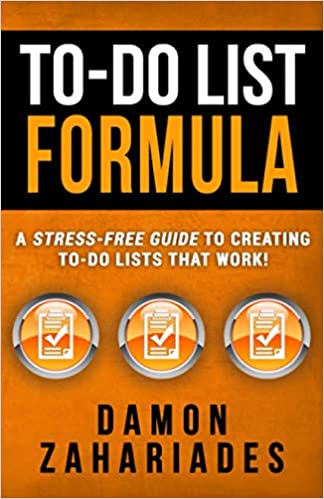To-Do List Formula — Book Summary
Introduction
Creating a to-do list has been of great help to various individuals because it emphasizes priorities and helps minimize tasks. For most, the lack of knowledge on utilizing this method properly results in frustration and stress. This book provides helpful ideas, strategies, and tips to get things done the right way.
Interesting quotes from the book
Without a proper strategy to manage tasks, our days spiral out of control.
— Damon Zahariades, To-Do List Formula
Goals provide vision, focus, and motivation. They also give us a gauge by which to measure our progress.
— Damon Zahariades, To-Do List Formula
Remember, being productive isn’t about keeping yourself busy. It’s about getting the right things done based on your short and long-term goals.
— Damon Zahariades, To-Do List Formula
Summary of the book To-Do List Formula
What is a to-do list? How can it help to get work done?
A to-do list is a form of task management where people compile tasks and determine what requires much attention. In a broader sense, a to-do list can do a whole lot more than one could ever imagine. Outlined below are facts highlighted by the author and the benefits of the subject topic:
- A to-do list helps us manage our workday: Knowing what to prioritize first is a great way to do tasks hassle-free. It also enables us to meet due dates and shows where time and consideration is dedicated.
- Everyone hates the feeling of being overwhelmed. Hence, a to-do list ensures that we focus on one task at a time. We can make our time worthwhile and feel more ahead.
- Being bothered with too much workload, we might feel irritated, and in most cases, it leads to procrastination. With the help of a to-do list, we can identify tasks depending on their urgency.
- A to-do list helps us become productive: This does not mean we should perform multiple tasks simultaneously, but rather finish more tasks in less time. A to-do list enforces our focus and helps us to accomplish goals.
- Creating a to-do list lessens our stress: The more due dates are met and tasks are finished in less time, we build our concentration and efficiently use time. It helps avoid frustration and guilt whenever we struggle to do a specific job. Upon following a to-do list, we have a sense of accomplishment that brings joy and happiness at the end of the day.
The author of the book further describes the productivity paradox. According to him, the productivity paradox is explained as too much reliance on particular task management, but with no apparent purpose and no show of progress; longer to-do lists usually give a sense of productivity but, in the end, is quite detrimental. The author cited common reasons why people fail to get through their plans.
- Misconception: One of the reasons we create a to-do list is to manage our tasks. In the literature, it is mentioned that a to-do list wasn't merely a tool to get things done, but rather a means to get "right" things done. It is necessary to know the distinct definition and purpose of a to-do list.
- Incomplete context: The author emphasizes that the deadline and reason the task must get done should be stated. Having no context about it on the to-do list makes it hard for us to determine how much attention each activity requires. It breeds a lack of discipline and an unclear vision for your goal.
- Inconsistency: Creating a to-do list avoids and saves from over-thinking. The author referred to this as a "brain dump repository." It avoids high-priority tasks from getting mixed up with the less-priority functions and avoids inconsistency and complications.
Methods and strategies
There are several strategies to enhance how you create a to-do list and how to manage them effectively.
The Massive, All-Inclusive List.
Brain dumping is the primary method used in this strategy. Here, one tends to write down all of the tasks one might think of and often ends up with a long list. The tendency is that high-priority tasks and low-priority tasks get mixed up; thus, one focuses on the more manageable tasks. It is a common strategy, but its effectiveness is yet to be determined.
The "Indicated Date Task" List
Indicating the starting date and the deadline are considered the essential aspect of creating a to-do list. It helps manage your time and choose where attention and focus are needed. However, although it is easy to write a day randomly, starting is most important.
The Master List and the Daily List
This strategy is creating a master list aside from a daily plan. A master list is a list where you can write down all of the tasks possible. It is something that must be finished within a specific deadline. However, a daily list of tasks is made for the entire day. These lists can work together for you to get the right things done. Supposedly, you have to review your master list at the end of the day. After reviewing them, you have to decide what task should be transferred to your daily list for you to work with it on the following day. This strategy requires you to be more detail-oriented and disciplined in carefully reviewing your set of plans.
The "3 + 2" Strategy
This strategy limits you to do only five tasks within the day. Using this strategy, you have to decide the three big tasks and two small tasks you have to perform. The three significant activities you choose must be done for about one to two hours, while your two small tasks for about thirty minutes. It helps you limit your scope of attention for that particular day. However, limiting yourself to do five tasks a day often leaves some behind.
The 1-3-5 Rule
Instead of limiting yourself to only five tasks for the entire day, the 1-3-5 Rule allows you to do nine jobs the whole day. These help you categorize the activities into one big task, three medium tasks, and five small tasks.
The Project-Based System
This strategy intends you to create a list and categorize them depending on how they relate with one another. You organize the to-do list according to the project. This strategy offers you a wide range of perspectives regarding your tasks. However, it would also be hard for you to decide what job to do because one might be experiencing scattered attention. It lacks detail about how you will spend your day, its due date, whether it is a high-priority task or not.
The 3-MIT Approach
MIT means the "Most Important Task". This strategy suggests choosing the three most important tasks from your list. After deciding those tasks, you have to set your mind that you must finish them during the entire day. Flexibility and practicality are vital in this strategy. However, the 3-MIT approach is too vague. It lacks structure and command; if not focused on accomplishing the task, you will eventually procrastinate. The effectiveness of this strategy depends on the discipline and the user's willingness to do the job.
The Kanban Method
The Kanban method visualizes the task progress and completion through the use of post-it notes. It helps you categorize what tasks fall behind "To Do," "Doing," and "Done." Thus, it guides you to easily track each task's progress and determine tasks that need your immediate attention whenever necessary. Color-coding makes it more visually pleasing and encouraging.
The Matrix System
This strategy was an idea of Steven Covey, who authored the book The Seven Habits of Highly Effective People. This strategy's central vision is to create four quadrants and decide what tasks are assigned in a specific quadrant. Those quadrants are labeled as "Important – Urgent," "Important – Not Urgent," "Unimportant – Urgent," and "Unimportant – Not Urgent." We can see a detailed specification about each task, enabling us to determine what needs enough attention. However, assigning the tasks on each quadrant might be difficult. Your productivity might also be affected because of too many options.
Getting Things Done (GTD)
This is a widely used task management system that people use nowadays, popularized by David Allen. It is about creating a master list and writing down all the thoughts that keep bothering you. You may then specify each task with its structure, context, and importance. Like the other given strategies, this also requires you to be flexible and manage every assignment.
Key Lessons
Lesson 1: Create a to-do list that works for you
There are a lot of strategies and methodologies to organize your tasks. Although they seem to be useful in many ways, their effectiveness depends on how we handle the assignment and how we discipline ourselves to do them. You can always select the best suggestions from each strategy and incorporate them into your own. You can also decide whether you would be creating your to-do list online or offline. You have to know where it is most comfortable.
Lesson 2: Practice consistency
Once you have started, make it a habit to practice daily, especially if you can notice its effectiveness. Practicing consistency is one of the best resolutions to be familiar with a to-do list's usefulness. We create a to-do list to serve as a guide in executing the tasks effectively.
Lesson 3: Do not be overwhelmed
There are tons of tasks that we might think of and include them in our to-do list. If a long list never ends, we are inclined to get intimidated and feel overcome.
Lesson 4: Never give up
There is no perfect to-do list. It has its usefulness as well as its flaws. Don't be discouraged.
Review of the book To-Do List Formula
I adore this book because it gives a comprehensible definition of what a to-do list is. It highlights various strategies and methodologies in making a well-organized and good quality list. All that is suggested is learnable and applicable, and useful in managing time.
Conclusion
We cannot deny the stress we may feel whenever we notice that our task management system is not working the way it is supposed to. Most people can "brain dump" tasks and list them down, but executing them is complicated. To-Do List Formula, written by Damon Zaharides, advises us on how we can overcome this challenge. There are many tips, suggested strategies, and advice that may help with improvement. Everyone will relate to this work of art. It is worth the read!
Don't miss the other book summaries on SunInMe.org

